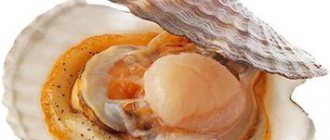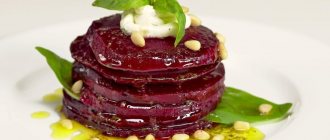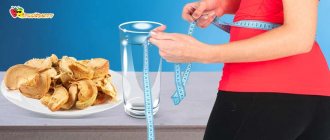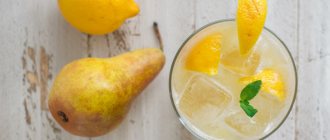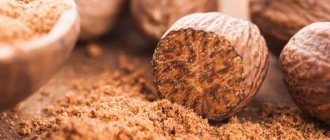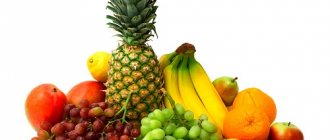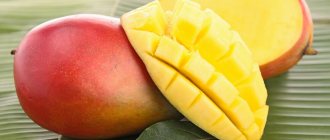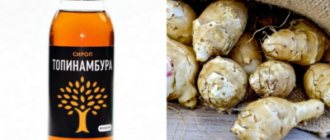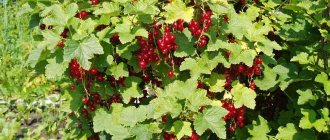Chemical composition
Nashi is an outstanding supplier of fiber, vitamins and minerals. Unique fruits contain a small amount of calories and many valuable microelements:
- vitamins K, B, E, PP, C;
- potassium, calcium;
- ash and magnesium;
- phosphorus, zinc and selenium;
- manganese, copper, cobalt;
- essential oils;
- pectin;
- tannins tannins.
This pear contains more fructose than glucose. It has a beneficial effect on the functioning of the pancreas, since the body does not need to produce insulin to absorb fructose.
Thus, this fruit is ideal for people suffering from diseases like diabetes and obesity.
Calories, nutritional value
The fruits have a sweet taste with a sour note, which gives the fruit an extraordinary piquancy. The pulp contains many components that are necessary for the human body.
- Chinese pear contains a lot of substances such as vitamins C and K, folic acid, phosphorus, calcium, potassium, magnesium, niacin equivalent, thiamine, choline, pyridoxine.
- 100 g of Chinese contains about 42 kilocalories (1 piece).
- The average weight of one fruit is about 200 g, and its calorie content is about 84 kcal.
- Contains a large amount of fruit carbohydrates (85% or 7 g).
- The remaining 15% (0.8 g) is protein and fat.
- This product has a medium glycemic index.
The benefits and harms of Chinese pear, calorie content, composition and beneficial properties
The Chinese pear appeared in stores in our region relatively recently. Its fruits have a light yellow tint, the flesh is dense and white, and small brownish spots can be seen on the peel.
This fruit, which is also known as neshi, is a descendant of the firm and tart Yamanashi pear.
Chinese breeders tried their best and obtained a Chinese pear based on it, the beneficial and harmful properties of which have already been relatively studied. They did everything to ensure that the new variety was free of disadvantages, but retained all the advantages of Yamanashi.
Our article is about the benefits and harms of Chinese pear for human health, its composition and calorie content, and areas of application of the fruit.
How to choose a good one
You can find Chinese pears in many stores . It is worth considering that the quality of the product sold will depend on storage conditions.
Fruits do not like heat and fresh air, so it is best to store and transport them in freezers.
So in the store, nashi should be located in the refrigeration compartments . If this is not the case, it is not recommended to make a purchase.
Before you buy a fruit, check its density . If it is soft, it may soon turn black. Under proper storage conditions, the shelf life is about two weeks.
Calories and nutritional value
The fruits have a sweet taste with a hint of sourness , giving them a special piquancy. And the pulp contains many components that are useful and even necessary for the human body.
Thus, the Chinese pear contains a lot of substances such as vitamins C and K, folic acid, phosphorus, calcium, potassium and magnesium, niacin equivalent, thiamine, choline, pyridoxine.
100 grams of Chinese pear contain about 42 kilocalories; 1 piece, the average weight of which is about 200 grams, will contain approximately 84 kcal.
The fruit contains the most carbohydrates (85% or 7 grams). The remaining 15% (0.8 g) comes from proteins and fats. The product has a medium glycemic index .
Beneficial features
The composition of the product includes many valuable components, which ensures its benefits for the body. The pulp contains a lot of fiber , which satisfies well and allows you to forget about the feeling of hunger for a while.
Therefore, Chinese pear is useful for losing weight . It contains a lot of water and nutrients, and at the same time few calories.
Improves mental activity, stabilizes the emotional background due to the presence of folic acid.
Due to the presence of magnesium in the composition, it has a beneficial effect on the cardiovascular system , preventing many problems associated with it.
Dietary fiber helps cleanse the intestines. Pectins help normalize blood pressure. The presence of potassium in the composition helps reduce the risk of developing cancer.
Phosphorus improves brain activity and promotes the synthesis of new cells. Calcium helps strengthen hair, nails and teeth.
The complex of vitamins and minerals contained in neshi has a general strengthening effect, improves metabolism and the functioning of the digestive system.
All the benefits of raw quail eggs, as well as possible harm and contraindications, are discussed in this article.
The beneficial properties and contraindications of celery for the body of men, women and children are presented in this material.
You can learn about the benefits and harms of parsley for women’s health from our publication.
Potential dangers and contraindications
As such, there are no contraindications to the use of Chinese pear, except, perhaps, its individual intolerance and allergic reaction.
But in order for delicious fruits to bring only benefit and not harm, follow these tips :
- do not abuse the product at night, as it has a pronounced diuretic property;
- It is not recommended to eat nashi on an empty stomach, otherwise heartburn and flatulence may occur;
- It is better to remove the peel - it may contain fertilizers and chemicals that are hazardous to health;
- do not eat unripe fruits, which can cause indigestion;
- Do not combine this fruit with meat and dairy products. This can cause serious stomach upset and problems with the digestive system. But Chinese pears are allowed to be consumed with fermented milk products, which cannot be said about other varieties.
You can eat Chinese pear just like other fruits. You can eat it fresh on its own, you can make jam , filling for baked goods, add it to ice cream, desserts, fruit salads.
Nashi goes well with Asian dishes. Good as an appetizer with sake.
There are no restrictions on the amount of pear consumption, but you still need to know when to stop. 500 grams of tasty and ripe fruits will be enough to saturate yourself with the unique taste and provide the body with useful substances.
It is better to eat fruits in the first half of the day , at least not at night, as they have a diuretic effect.
Do you want to know how radishes are beneficial for pregnant women? Can a vegetable harm an expectant mother? Find answers to your questions in our article.
The medicinal properties of red currant and its use in folk medicine are discussed in this material.
Read about the beneficial properties and contraindications of raspberries in this publication.
In cooking
Here are some simple and interesting recipes using neshi.
Chinese pear in sake and warm chocolate sauce . For the recipe you will need 600 ml of water, 8 tablespoons of sake, 2 pieces of anise, 2 pieces of lime, 2 pieces of pear, 150 ml of cream, 75 g of dark chocolate, 50 g of butter, a cinnamon stick.
Pour water, sake into a saucepan, add the juice and zest of one lime, anise and cinnamon. Let it boil. Simmer for five minutes, then reduce heat.
Add the whole, peeled pears, cover and simmer for 45 minutes until softened. Remove from heat and leave to cool in syrup.
To prepare the sauce, melt the chocolate and mix it with butter and cream. Then add the zest of another lime and mix thoroughly.
Cut the pears in half and remove the inside. Place in serving bowls and pour over the resulting chocolate syrup.
Salad with cheese and arugula . A very spicy salad, for which you will need 2 pieces each of Chinese and Conference pears, 150 g of arugula, one lemon, 150 ml of dry white wine, 250 g of pine nuts, 50 g of sheep cheese, sea salt, ground black pepper, butter grape seeds - to taste.
Wash and dry the arugula leaves. Wash the pears, peel them, cut them, remove the middle and stem. Cut every fourth part in half, and cut the resulting parts lengthwise into half-centimeter fragments. Sprinkle with lemon juice.
Heat up the frying pan. Pour the wine there in a centimeter layer. Once it is heated, add the cane sugar and let it dissolve. Then the wine should evaporate by half.
Place in the Conference pan. Cook over high heat until the wine almost completely evaporates and the fruit becomes dark and soft.
Cut the cheese into thin slices. Place arugula on dry plates, then fried conferences, fresh nash and cheese.
Drizzle with oil and lemon juice. You can sprinkle with pine nuts. Add salt and pepper to taste.
For weight loss
The low calorie content of the Chinese pear and the presence of a large number of useful components in it make it a wonderful addition to the diet.
A couple of fruits can be a great snack that will help you get rid of hunger for several hours.
Nashi will help satisfy your sweet tooth without the risk of gaining extra pounds. After all, these fruits are much healthier than chocolate or cakes, and they contain ten times fewer calories.
Therefore, if you are watching your figure, make it a rule to replace unhealthy sweets with juicy and tasty fruits .
In medicine
This product is recommended for those who suffer from functional digestive disorders.
It will help normalize the heart rhythm, improve well-being and relieve nervous tension. Juices and compotes based on nasha help in the fight against diarrhea.
Chinese pear juice is recommended for diabetics, as it normalizes blood sugar levels. Start with 50 mg and gradually increase the dose to one glass. It is recommended to drink juice 30 minutes before eating.
Boiled and baked pears, as well as thick decoctions based on them, help with severe coughing, accompanied by attacks of suffocation.
Both raw fruits and juices and decoctions based on them help remove excess fluid from the body, strengthen the walls of veins and capillaries, and prevent varicose veins and heart problems.
It is known that Chinese pears almost do not accumulate chlorine and sodium, therefore they are useful for various kidney pathologies and can be included in salt-free diets.
Varieties
Today, several hundred types of Chinese pears bear fruit all over the world, with different sizes and tastes, with different periods of ripening and yield. However, on the territory of Russia, with its difficult climatic conditions, less than 10 species grow.
The distinctive characteristics of these species are the trees' undemanding requirements for soil, high fertility and greater resistance to frost, drought, and various types of pests. Afraid of the flower bug.
The following species are usually grown in Russia:
- Morning freshness
- Kosu
- Hosu
- Olympic (there are other names: Korean giant or great Korean)
- Khrustalnaya
Let's look at the features of each type below.
Morning freshness
Morning Fresh pear is a summer variety. You can collect it already in the first half of August. The tree gives an excellent harvest if the pollinators are pear species such as Oriental golden, Bronze or Kieffer.
It begins to bear fruit quickly: 3-4 years after planting. It is resistant to fungi and bacterial diseases, and in the southern regions it tolerates cold temperatures. The fruits are small, round, yellow, weighing about 115-180 grams.
Kosu
This is another species whose harvest maturity occurs in the second half of July. The tree is resistant to frost and pests. Usually begins to bear fruit in the second year. The fruits are small in size: 130-160 grams, very rich bronze color. The pulp is sweet and juicy.
Hosu
Despite the fact that this species is self-pollinating, proximity to other Chinese pears will contribute to a good harvest. Autumn species, harvesting begins in the second half of August.
The tree begins to bear fruit early: 2-3 years after planting. It is resistant to frost and pests. The fruits are brown, with very dense but juicy sweet pulp. Weight can reach 300 grams.
Olympic
The popularity of this autumn variety of Chinese pear is due to its characteristics: early maturity, resistance to pests and low temperatures. Neither scab nor powdery mildew are dangerous for this variety. The tree begins to bear fruit in the second year and bears round fruits of a beautiful golden color with small gray spots. The weight of the fetus reaches 160 grams.
The popularity of the variety in Russia is growing rapidly. This environmentally friendly species captivates both with its rapid adaptation to climate and soil, and with its excellent taste and aroma of fruit. If you want to plant a tree that will delight you with its fruits, choose the Chinese pear, and you will not regret it!
Khrustalnaya
One of the most popular varieties is Khrustalnaya. It is valued for its fertility, resistance to temperature fluctuations, and various fungi. The fruits have firm yellow or snow-white flesh.
The thin peel has a sandy color and small light brown spots. This Chinese pear ripens in the fall, during which time it is already possible to harvest.
Description of the species
Several thousand years ago, the wild Yamanasha pear grew in the vastness of China. It had very hard, sour, completely inedible fruits. But ancient breeders managed to eliminate its shortcomings by combining a pear with an apple tree, and turn them into advantages. Nashi culture has been grown in Asia for several centuries. It belongs to the rose family and is cultivated as a shrub or low tree.
We invite you to read: The washing machine does not drain water: the causes of the problem. What should I do if the machine just hums and water remains after washing? Repair Tips
Around April, depending on the region of growth, the tree is covered with white five-petaled flowers. In East Asia, neshi is a symbol of spring. It is grown in urban and rural gardens. And in the city of Kamagaya-Shi (China, Chiba Prefecture) it is considered the official flower of the city.
After flowering ends, fruits begin to grow and develop on the tree. In their shape, they are more similar to apples, the same round or slightly oblong, in some cases cone-shaped. The color of the surface can also be different: from white to light green, bright yellow, bronze with blush.
The fruits remain firm even after ripening, making them easy to transport and store. At the same time, the flesh is juicy white (light cream), crispy and sweet. Interestingly, even unripe fruits have a very sweet taste. It does not become softer, no matter how long the harvested crop is stored.
Nashi bears fruit well. Already 3 years after planting the pear seeds, the first fruits appear on the young tree. For the most part, the weight of an individual fruit is 150-200 grams, although you can also find larger pears whose weight reaches 300-400 grams.
The Chinese pear has many names - sellers often call it Japanese, shortbread, Taiwanese or neshi. It is known for certain that the variety was created on the basis of Yamanashi - a forest pear. The fruits of the ancestor, although large, were very sour and hard. Breeders, taking from Yamanashi's high adaptive abilities and frost resistance, endowed them with a new variety - neshi.
The Chinese pear, in comparison with its forest ancestor, has excellent taste. Today, neshi is popular not only among gardeners in China or Japan; this variety is grown in many countries. The main condition for growing is a suitable climate.
In Russia, conditions are favorable for us only in the south. But its hybrids, which are more resistant to frost, can bear fruit in the middle zone. Thus, a hybrid of Chinese and Far Eastern pears can withstand frosts down to -35 °C.
Tree and fruit
Based on the wild pear, many varieties have been created that have inherited its frost resistance. All varieties, while having a lot of differences, have a set of common features:
- Great tree height. Subspecies of Chinese pear reach a height of 4-10 m. Trees of the classic variety are tall. But hybrids - they are grown in Russia, much lower.
- Self-fertility. Almost all subspecies of Nashi are self-fertile and do not require pollinators. The absence of pollinating pears does not affect the yield. But the appearance of the fruits is reflected in the fact that without pollinators they are smaller and uneven.
- Frost resistance. There are hybrids that can withstand low temperatures, others can survive the winter only in an insulated state - they are wrapped in straw or covered with spruce branches.
- Lifetime. The tree lives for about half a century. The lifespan of grafted trees is affected by the rootstock - with dwarf trees the tree lives up to 20 years, with vigorous trees - 50 years.
- Productivity. While the tree does not bear fruit, it quickly grows upward. When the fruits appear, the tree grows more slowly, and the yield gradually increases. By the 5th year of life, the tree produces up to 80 kg of fruit, and by the 30th year – up to 2 kg. Yields of up to 0.5 tons per tree have been recorded.
- Disease resistance. All varieties are characterized by high immunity. They practically do not suffer from scab, rot, parasites and infections.
- Cyclicity of fruiting. The tree is harvested annually. If pruning is done poorly, the plant loses strength and productivity.
Neshi fruits have an unusual shape - they are a cross between an apple and a pear. Features of Chinese pear fruits:
- The juicy and fragrant pulp has an excellent taste, combining sweetness and acidity. The aftertaste has spicy notes.
- The fruits have thin skin.
- Unripe nashi are sour and inedible. They are even dangerous for the body, as they contain a lot of organic acids.
- Color, depending on the variety, ranges from soft green to bronze.
- The average size is 4 cm in diameter.
- Weight – 120-300 g.
- Versatility - the fruit is delicious fresh and processed.
In stores, nash is usually sold in paper bags - in them, unripe fruits reach their condition. They are stored at room temperature, and after ripening - in the refrigerator.
Neshi fruits have a calorie content typical of pears - 42 kcal per 100 g. These fruits do not contain starchy carbohydrates, so they are suitable for dietary nutrition. It is recommended to eat one piece of fruit three times a day.
100 g of fresh neshi fruit contains:
- water – 45 g;
- dietary fiber – 2 g;
- ash – 0.2 g;
- vitamins and minerals.
Chinese pear contains a lot of zinc, selenium, calcium, manganese, copper, and magnesium. Neshi fruits are especially rich in phosphorus and potassium. Moreover, this fruit contains five times more potassium than all other microelements. The fruits are also rich in choline, vitamins C and K.
Why do you need a Chinese pear?
Fruits help the body maintain health and strength. The usefulness of the fruit is explained by the content of active substances in the fruit crop at the biological level, which help strengthen, restore body functions and normalize the functioning of all systems.
Therefore, they are considered a panacea for many diseases. When taken, improvement and restoration of health can be observed, since the beneficial properties of the Chinese pear are:
- stimulation of the immune system, which is a protective device against infections and environmental irritants;
- improvement of hormonal levels and thyroid function;
- activation of the protein synthesis process necessary for cell formation;
- regulation of the musculoskeletal system;
- balancing the digestive system;
- restoration of deformed areas of the nervous system, feeding the body with energy;
- normalization of gastric secretion;
- improved digestion, increased appetite;
- for type 2 diabetics, Chinese pear will cleanse the body of excess toxins and cholesterol, which are harmful to health, and also normalize blood sugar levels;
- are a supplier of valuable substances for pregnant women, promoting the development of the fetus.
These properties of the Chinese pear, with constant consumption, will help cope with the unpleasant symptoms of diseases, and the chemical composition of the fruit will help replenish the reserves of minerals and trace elements in the human body.
For adult women and men
Chinese neshi helps men and women maintain a toned figure and speed up metabolic processes. Due to the low energy value of fruits, nutritionists advise eating fruits at least 2-3 times a week: eating them raw, baked, or making smoothies. The combination of fruits and cottage cheese saturates the body so perfectly that you won’t want to indulge in unhealthy desserts.
You can also spend fasting days on a pear diet. They have been proven to help you lose 1-2kg per day. Moreover, these fruits help maintain potency as they are a natural aphrodisiac.
Since Chinese pear contains a large amount of folic acid, it is recommended in preparation for pregnancy and during its first trimester. Pregnant women have double the need for minerals and vitamins, and Nashi more than covers them without adding extra calories. Cosmetic masks made from grated fruits can be compared to cleansing peels, after which the skin looks fresh and young.
For children
The fragile organism of infants is susceptible to viruses and colds, and Chinese pear naturally lowers body temperature and maintains normal acid-base balance.
Consumption of Chinese pears is beneficial during the period of active growth: the musculoskeletal system and immunity are strengthened.
The main thing is that the baby is not allergic to fruits. Pediatricians recommend giving pears only after the child turns one year old. These fruits are not suitable for early feeding.
For the elderly
Very often, nashi advise older people to eat. Firstly, neshi is useful for maintaining mental clarity. Secondly, it is used to prevent diseases of the urinary system. Chinese pear keeps the kidneys in order and has a mild diuretic effect.
Strengthens the heart, keeps the vascular system clean and clears cholesterol plaques. In addition, fruits normalize blood pressure. The ancient Chinese started their day with a glass of freshly squeezed juice and then felt energized throughout the day.
Do you need Chinese pear to lose weight?
Sand pear is introduced into the diet due to its beneficial properties. Due to its low calorie content and high water content, it can help you lose a few pounds. But this is only if the fruit is consumed instead of sweets or as snacks to eliminate the acute feeling of hunger.
Not only the Chinese pear, but also other fruits perfectly maintain weight in order in the absence of dishes in the diet with “fast” carbohydrates (rolls, cakes, pastries), which contribute to weight gain. But you should not eat more than 500-600 g of pear per day, as it is an exotic product and can be harmful in excess.
Attention! Before consumption, you need to peel the Chinese pear, since the surface layer may be treated with pesticides or compounds to increase shelf life.
Chinese pear: what it looks like, the benefits and harms of a pear, where it grows and what its calorie content is
Chinese pear, or as it is also called in the east, nesha, is a sweet, aromatic fruit rich in vitamins and minerals. It is used in different directions - in cooking, cosmetology, medicine and dietetics. You can learn more about the benefits of Chinese pears below.
Chinese pear: what it looks like, where it grows
The fruits of the Chinese pear have a round shape, slightly elongated near the stalk. The color of the peel can vary from light yellow with a greenish tint to bronze - this depends on the type of pear and its degree of ripeness. It is also worth noting the presence of small brown specks over the entire surface of the fruit.
The pear pulp is white, dense, crunchy and at the same time very juicy. Its taste is sweet, with a slight sourness that occurs closer to the core of the fruit.
The variety was bred in the eastern regions. In the vastness of Russia, it is mainly grown in the Primorsky Territory. The trees withstand frost and pest attacks well, so Chinese pears can be safely grown in the central zone of our country. True, there is one pest that is still terrible for the Chinese woman - the flower beetle.
On a note. Amateur gardeners value this variety of pears for its ability to bear fruit quickly - already in the second year after planting you can enjoy the first small harvest. The yellow pear is the most common and can often be found on supermarket shelves.
Composition, calorie content and weight of one Chinese pear
The fruit of the Chinese pear reaches 4 cm in diameter. It is impossible to say exactly how much one Chinese pear weighs; it depends on its variety. Its minimum weight is about 150 g (white pear variety Pyrus Serotina), but the fruit can reach 300 g depending on the variety.
The main weight of a pear is water. Approximately 42 g of 100 g of pulp is liquid. The rest is fiber, ash, minerals and vitamins.
Thyme herb medicinal beneficial properties and contraindications
Most of the nutrients are:
- Phosphorus. It is also called an energy accumulator in the body, as it participates in metabolic processes and helps convert substances into energy. The element also takes part in the production of certain hormones and enzymes, in the formation and strengthening of bone tissue.
- Potassium. Stimulates the normal formation of enzymes, maintains the health of the heart and blood vessels, and regulates water-salt balance.
Ripe fruits contain zinc, copper, calcium, and magnesium in smaller quantities. Among the vitamins, the composition contains choline, ascorbic acid and vitamin K.
There are also:
- folic acid, essential for women's health;
- thiamine, responsible for the development of muscles and bone tissue, performance and good appetite;
- pyridoxine is a vitamin necessary for the normal absorption of fat and protein by the body;
- many other substances in smaller quantities compared to the above.
Like all plant products, pear has a low calorie content - 100 g of pulp contains 42 kcal. Therefore, it is often used in the diet menu.
On a note. In our open spaces, other names for this fruit are also known - Japanese, Asian, sand (due to its speckled color) pear, neshi, nashi.
The following can be said about the general benefits of Chinese pear:
- This fruit has a beneficial effect on the digestive process.
- The phosphorus it contains has a positive effect on health, bone and muscle growth. This is a particularly important point for athletic people.
- Thanks to potassium, the heart and blood vessels are strengthened, which means the risk of developing diseases of this system is reduced significantly.
- It has an anti-cancer effect on the body, that is, it prevents the formation of pathological cells.
An equally important benefit of pear is its low calorie content.
This means that it is recommended to include it in the diet of those people who want to get rid of a few extra pounds or simply want to make their menu healthier and healthier.
The benefits of fruit for men are manifested in the following effects:
- general strengthening effect for the whole body;
- prevention of inflammatory processes in the genital organs;
- prevention of impotence.
Representatives of the fair sex are recommended to eat Chinese pear during pregnancy - the folic acid it contains has a positive effect on the development of the fetus and the condition of the mother.
But there is a limitation - no more than 500 g of fruit per day.
Chinese pear is also useful for children:
- vitamins contained in fruits have a positive effect on the developing body;
- Thanks to vitamin C, the immune system is strengthened;
- energy production increases;
- brain activity improves.
It is worth noting that pears are not used as complementary foods. It is allowed to introduce it into the diet of a child over three years old. At an earlier age, digestive problems may occur.
Use of Chinese pear in cooking
Pears are used for desserts, as a filling for pies and pastries, as a topping in ice cream or as a component of fruit salad. Canned food is also used to prepare jams and compotes that are very sweet and aromatic.
Useful properties for beauty
In home cosmetology, the pulp of the fruit is used to create firming masks. They have a nourishing, antioxidant and strengthening effect on the skin and hair.
Facial skin care
The easiest way to use pear puree is to apply it in its pure form.
- A pear face mask is useful for its antioxidant properties - it helps eliminate inflammation if there is a rash or small wounds on the skin. Vitamins penetrate deep into the skin through the pores and improve blood circulation and accelerate metabolic processes. After using the mask, your complexion becomes healthier and fresher.
- The benefits are observed not only from the fruits of the tree, but also from its leaves. You can prepare a decoction from them and use it as a tonic for wiping your face. The product works well against increased fat content, gradually normalizing the functioning of the sebaceous glands.
- Pear pulp can also be used for dry skin. Pear puree is combined with a small amount of olive oil and chopped steamed oatmeal.
Treatment of varicose veins on the legs with folk remedies at home
Hair care
The pulp of sand pear can also strengthen hair. Masks based on this fruit are recommended to be used to diversify the usual list of products used at home.
- For weakened and prone to hair loss, a combination of pear and swollen gelatin will be useful.
- A mask made from fruit pulp mixed with lemon juice, egg and vegetable oil will help strengthen and heal your hair.
Masks are applied only to hair washed with shampoo for 15 - 20 minutes. If the mask contained fatty components, after washing it off, it is recommended to rinse your hair with water and lemon juice.
Help with weight loss
A pear in a diet menu can be an excellent snack - a couple of fruits of this fruit can satisfy the symptoms of hunger for 2 - 3 hours. They also relieve the desire to eat something sweet - the fruit contains sugar. But it is still much healthier than chocolate and cakes.
Pear can be added to other dietary dishes - fruit salads, oatmeal, sugar-free rice. It makes excellent smoothies, and pear puree makes diet popsicles.
Contraindications for use
Chinese pear can cause irreparable harm to the body if it is consumed incorrectly or without taking into account contraindications. For example, consuming fruit, meat and a dairy product at the same time will cause severe indigestion, since these categories of products are completely incompatible.
A significant contraindication to the use of neshi, as for almost all products, is only one circumstance - individual intolerance. In addition, the pulp of the fruit has a high sugar content, which means that the pear is contraindicated for diabetics.
The fruit can aggravate the condition during an exacerbation of diseases of the digestive organs - pancreatitis, flatulence, increased acid production in the stomach.
In the absence of contraindications, Chinese pear can and should be included in your diet. This is a healthy, juicy, bright fruit that will definitely earn your sympathy.
Source: https://CreativPortal.ru/kitajskaja-grusha-kak-vygljadit-polza-i-vred-grushi-gde-rastet-i-kakaja-kalorijnost/
Harm
Chinese pears are very beneficial for the human body, but in some cases they are also harmful. You should not eat them on an empty stomach or consume unripe fruits - this can cause severe digestive upset.
Avoid eating fruits at night as they have diuretic properties. Pears are not mixed with meat and dairy products. When consumed, the peel is peeled because it contains many chemicals that are often used on fruits to increase shelf life. People with allergies are not recommended to use it.
How much can you eat in a day?
You can afford to eat several Chinese pears per day. It is better for pregnant women to reduce this amount to 1-2 fetuses per week. Do not eat pears on an empty stomach or before bed. They have diuretic properties and hence will lead to restless sleep.
Chinese pear is usually consumed fresh, since it is in this version that all the necessary substances are stored, including vitamins and amino acids. They often add it to cakes or make jam from it, but in this form it will not be so beneficial to the body.
If you want to follow a fruit diet, it is very important to agree with your personal nutritionist on the number of pears you will eat, as only he can determine how much and with what foods you should eat them.
Varieties of apple pears
Today, Chinese pear planting material can be found in various nurseries. In most cases, it is represented by two types of nesha:
- Akanashi - has round fruits with brown or bronze skin;
- Aonashi - elongated, ovoid fruits colored in green and yellow tones.
At the same time, their flesh is usually white or light cream, but not “oily” like ordinary varieties, but slightly “sandy”. It is due to this property that Nashi is sometimes called a sand pear.
Work to improve the properties of apple pear continues today. Modern breeders have developed varieties and hybrids that can easily withstand the negative effects of temperate climates and unstable weather conditions. The Asian “guest” can be found in the gardens of our domestic summer residents - lovers of exotic things.
Breeders have developed dozens of varieties of Chinese pear. The most winter-hardy and unpretentious varieties are grown in Russia. Gardeners choose Nashi, which are undemanding to soil, survive harsh winters, and withstand drought and pests. Let's take a closer look at the varieties that are the most popular among domestic gardeners.
Kosui is a summer variety that bears fruit in the second half of July. Advantages of the Kosu variety:
- frost-resistant;
- resistant to diseases and pests;
- early ripening - ripens earlier than all other Chinese varieties.
Medium-sized fruits - up to 160 g. Color - rich bronze. The pulp of the fruit is juicy - an ideal summer fruit.
Hosui is a self-pollinating variety, but the presence of other varieties of Chinese pears nearby helps increase yields. The tree pleases its owners with fruits already in the second or third year of planting. The variety is considered an autumn variety, but harvesting begins in the second half of August. The fruits ripen unevenly, so harvesting is carried out in several stages. Cleaning ends in mid-September.
We invite you to familiarize yourself with Pear puree for the winter without sugar
Advantages of the Hosu variety:
- pest resistance;
- frost resistance;
- large fruit;
- early ripening - pears appear in the 2-3rd year of planting;
- excellent taste, the pulp is juicy and sweet, contains up to 12% sugar.
The fruits weigh 160-200 g, but can reach 300 g. The color is rich bronze-brown. The pulp is dense - when cutting the fruit with a knife, you have to apply force.
Olympic
Olimpic is an autumn variety with excellent characteristics. Its advantages:
- early ripening - the tree bears fruit already in the 2nd year of planting;
- resistance to pests;
- frost resistance;
- not afraid of diseases, including scab and powdery mildew;
- quickly adapts to climate and soil;
- excellent taste characteristics, pleasant fruity aroma.
Olympic is also called the Great Korean Pear or the Korean Giant. The fruits of "Olympic" are round and have a pleasant golden hue. The entire surface is covered in small gray specks. Fruit weight – 160-200 g. The taste is original, xylo-sweet, the pulp is juicy. These pears are pleasant to eat fresh, they can also be stored - the fruits have excellent shelf life. Harvesting is in September.
Morning freshness
This summer variety is popular in the middle latitudes of Russia. It is partially self-fertile - to increase productivity, it is recommended to plant varieties of Chinese pears nearby - Bronze, Eastern Golden, Kieffer.
The variety tolerates frost well and has strong immunity to bacterial and fungal diseases. The fruits are small, weighing 100-150 g, they have a bright green skin covered with gray specks.
Khrustalnaya
Autumn early-fruiting variety. Already in 2-3 years the tree produces high yields. The variety is resistant to fungal infection. The fruits weigh 160-220 g, the color is light yellow. A distinctive feature is low calorie content. They have juicy but firm flesh. The taste is delicate, fruity.
Comparative table of popular varieties of neshi
What can I cook?
This is a product that most people consume raw. But even in culinary dishes, Chinese pear serves as an excellent addition, giving the food new notes. Fruit salads, various desserts, cakes: the list of dishes in which you can add Chinese pear is long.
You can add to this list ice creams that include exotic fruits as toppings, jams, or assorted fruits combined with other fruits. Since it comes from Asia, it is often used in Asian cuisine, which has tested all the beneficial properties of this fruit.
Useful properties for maintaining beauty
The Chinese believe that neshi helps prolong youth by promoting timely cell renewal. In addition, this product helps strengthen hair, teeth and nails, and also improves skin condition.
To preserve youth and beauty forever, you can not only eat this fruit, but also make cosmetics based on it.
A mask made from fruit pulp will prevent premature wrinkles, give hair a healthy shine, and also eliminate dandruff. And fruit juice can help with freckles and age spots if you rub it frequently on your face.
How to choose the right one
The characteristics of the fruit when choosing are peel, density and taste. As a rule, the quality and usefulness of a fruit are related to the rules for its storage. Storage in heat and fresh air is contraindicated, so they should be kept in refrigerators in the store.
When purchasing, please observe the following rules:
- in the off-season, the best place to buy a Chinese pear is the market, where you can check it and determine the degree of ripeness (juicy pulp without lumps);
- the fruit is not very soft and not very dense;
- the peel should have a smooth surface and small spots;
- There should be no black spots or mold particles on the pear.
There is no need to take overripe or unripe fruits. An overripe Chinese pear will turn brown quickly and you will have to eat it or throw it away immediately. Unripe fruits are tasteless and harmful to the digestive system.
How to grow nashi
Today, varietal Japanese pear seedlings can already be found among the assortment of Russian nurseries specializing in the cultivation of fruit and berry crops. As a last resort, you can grow them yourself. You can use the pits of store-bought fruit as seeds. They have a fairly high level of germination.
Like any other pear, neshi is not picky and does not require special care. It is enough to provide the plant with regular watering and timely spraying with pest control agents.

